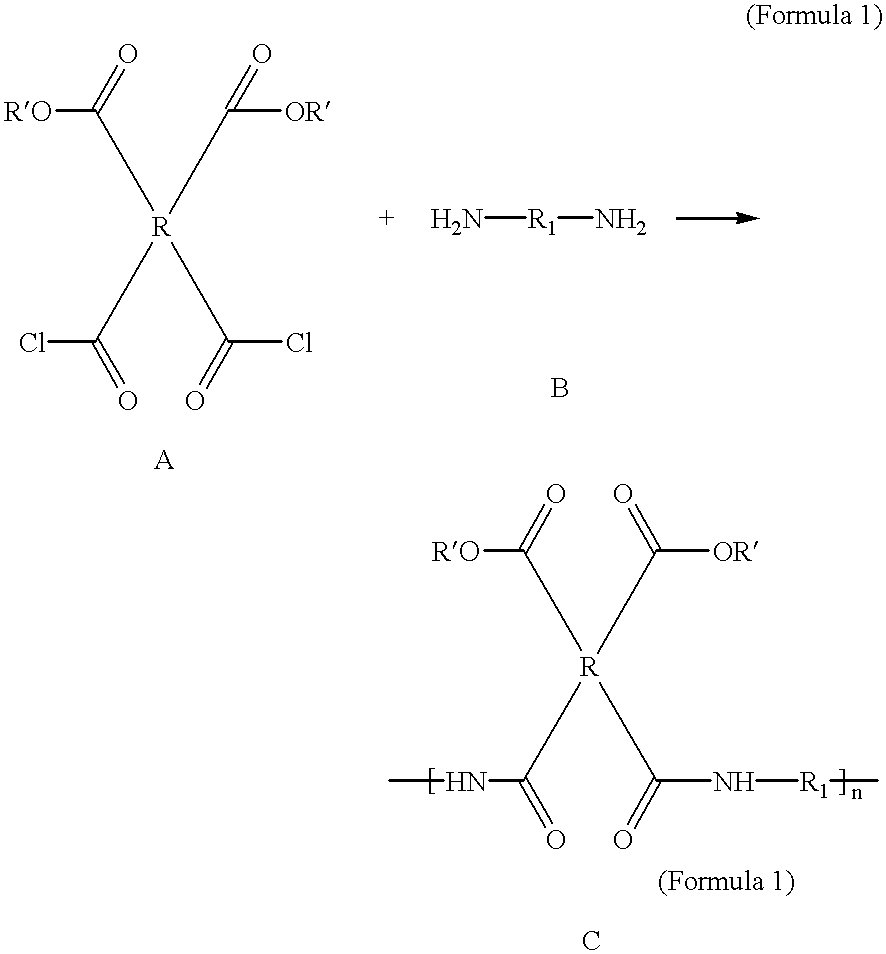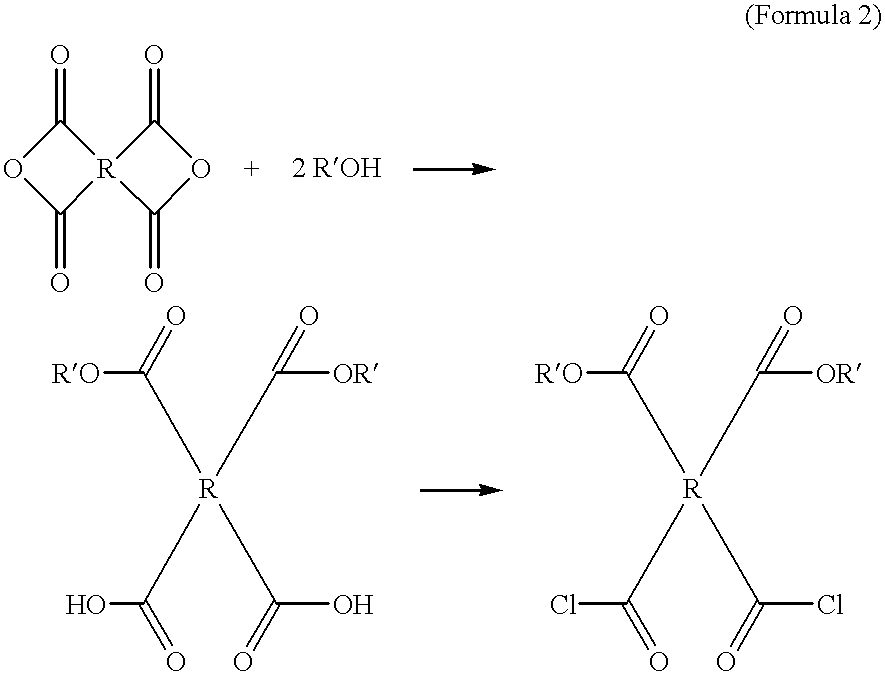Photosensitive polyimide precursor compositions
a polyimide and precursor technology, applied in the field of photosensitive polyimide precursor compositions, can solve the problems of high film loss during development, damage or loss of relief image, adverse effects of photochemical cross linking reaction in producing insoluble products,
- Summary
- Abstract
- Description
- Claims
- Application Information
AI Technical Summary
Problems solved by technology
Method used
Image
Examples
example 2
[0036] A negative resist composition, prepared by mixing:
2 37.34 wt. % Polyamic acid ester (component C) produced from 4,4'- oxydiphthalic anhydride (=ODPA), 4,4'-diaminophenyl ether (=ODA) and 2-hydroxyethyl methacrylate (R') 6.54 wt. % A 20% NMP solution of titanocene corresponding to Formula 4 (component D) 5.61 wt. % Tetraethylene glycol dimethacrylate (component E) 0.05 wt. % 1H-tetrazole (component F) 0.07 wt. % Para-benzoquinone (component G) 0.74 wt % Silane adhesion promoter (component J) 49.64 wt. % N-methylpyrrolidone (component H)
[0037] was rolled overnight to yield a clear resin solution and was then subjected to a pressure filtration through filters of pore width 0.2 microns. The resin solution was spin coated onto bare silicon and copper-coated silicon wafers and then dried on a hot plate for 7 minutes at 100.degree. C. In this way, 11 .mu.m thick films of uniform thickness were obtained on the wafers. The wafers were then exposed to monochromatic light with a wavelen...
example 3
[0038] A negative resist composition, prepared by mixing:
3 26.44 wt. % Polyamic acid ester (component C) produced from 4,4'- oxydiphthalic anhydride (=ODPA), 4,4'-diaminophenyl ether (=ODA) and 2-hydroxyethyl methacrylate (R') 0.93 wt. % Titanocene corresponding to Formula 3 (component D) 3.97 wt. % Tetraethylene glycol dimethacrylate (component E) 0.034 wt. % 1,2-cyclohexanediamine tetraacetic acid hydrate (component F) 0.053 wt. % para-benzoquinone (component G) 0.08 wt. % CDAC (component I) 0.53 wt % Silane adhesion promoter (component J) 33.98 wt. % Cyclopentanone (component H) 33.98 wt. % N-methylpyrrolidone (component H)
[0039] was rolled overnight to yield a clear resin solution and was then subjected to a pressure filtration. The resin solution was spin coated onto a silver-coated silicon wafer and then dried on a hot plate for 2 minutes at 110.degree. C. In this way, a 4.5 .mu.m thick film of uniform thickness were obtained on the wafer. The wafer was then exposed to broadba...
example 4
[0040] A negative resist composition, prepared by mixing:
4 38.28 wt. % Polyamic acid ester (component C) produced from pyromellitic dianhydride (=PMDA), 4,4'-diaminophenyl ether (=ODA) and 2-hydroxyethyl methacrylate (R') 6.70 wt. % A 20% NMP solution of titanocene corresponding to Formula 4 (component D) 5.74 wt. % Tetraethylene glycol dimethacrylate (component E) 0.05 wt. % 1H-tetrazole (component F) 0.08 wt. % Para-benzoquinone (component G) 0.76 wt % Silane adhesion promoter (component J) 48.39 wt. % N-methylpyrrolidone (component H)
[0041] was rolled overnight to yield a clear resin solution and was then subjected to a pressure filtration through filters of pore width 0.2 microns. The resin solution was spin coated onto bare silicon and copper-coated silicon wafers and the wafers were dried on a hot plate for 6 minutes at 105.degree. C. In this way, 15 to 17 .mu.m thick polymer layers of uniform thickness were obtained on the wafers. The wafers were then exposed to broadband rad...
PUM
| Property | Measurement | Unit |
|---|---|---|
| temperatures | aaaaa | aaaaa |
| wavelengths | aaaaa | aaaaa |
| temperatures | aaaaa | aaaaa |
Abstract
Description
Claims
Application Information
 Login to View More
Login to View More - R&D
- Intellectual Property
- Life Sciences
- Materials
- Tech Scout
- Unparalleled Data Quality
- Higher Quality Content
- 60% Fewer Hallucinations
Browse by: Latest US Patents, China's latest patents, Technical Efficacy Thesaurus, Application Domain, Technology Topic, Popular Technical Reports.
© 2025 PatSnap. All rights reserved.Legal|Privacy policy|Modern Slavery Act Transparency Statement|Sitemap|About US| Contact US: help@patsnap.com



